47 Ronin #1 ($3.99, Dark Horse)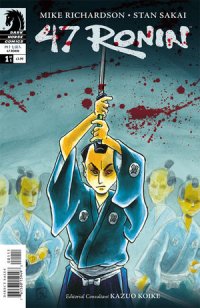
by D.S. Randlett (@dsrandlett)
I’m amazed that history is not something that has been dramatized in comics. As an enthusiast for ancient Greek and Roman letters, I am not at all surprised that Frank Miller managed to lionize the 300 Spartans, as that story seems to fulfill his particular brand of futile manly bluster. But where are the comics dramatizations of the naval campaign against the Persians in that same war? Where is the dramatization of the life of Solon? Pick any period of history and one can find stories of action, guile, and humanity.
The first issue of Mike RIchardson and Stan Sakai’s treatment of the story of the 47 Ronin, a definitive Japanese tale with one toe in history and another in fable which has served as the touchstone for the beloved samurai genre since its inception, seems to have its eyes focused squarely on the humanity of its tale. A hallmark of historical comics has often been to have an eye on stories of martial virtue, and it’s easy enough to see why. It relies on most of the pulp touchstones of the medium, something that the medium has struggled to grow beyond just as much as the superhero. Here, nary a sword is drawn until the very end, and even then no blood is shed. Rather Richardson and Sakai tell the story of a good man learning good court etiquette but learning about the corruption that is inherent in that. He must choose between upholding good etiquette and his own honor. I think you know how that turns out.
In terms of storytelling, there is nothing really inventive here, but then I don’t know that there really needs to be. The emotions present are very restrained (until they explode, of course), and the pacing is reminiscent of classic Japanese film. Emotions are restrained but present, and Sakai’s panels here draw the eye and convey the same sort of emotive lingering. Sakai hasn’t changed his trademark style much, even though he’s not drawing animals here. Still, his mixture of classical Japanese art and American alternative comix styles works for him, and the gaze that he brings to this story really helps Richardson’s basic to the point of bareness script breathe and take on a thematic texture that it might not in lesser hands.
And while I appreciate the decision to tell a humane story rather than a brawny one, this issue seems lacking in power. The real story hasn’t begun yet, after all, and this issue feels something like one of those prequel DTV animated films that gets released alongside an action film that gives you story that has very little power on its own and is really unnecessary to the main event. Still, the skill in the telling of this particular part of this tale bodes well for what is to come
47 Ronin is about what you’d expect from Richardson and Sakai in terms of quality. It’s good and up to its task, but nothing earth-shattering. There are certainly worse ways to spend your comics budget this week, but probably others that are more thrilling.
Rating: 




Out of a Possible 5 Stars
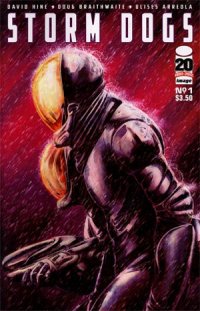 Storm Dogs #1 (Image, $3.50)
Storm Dogs #1 (Image, $3.50)
by Graig Kent
The first few pages of Storm Dogs are a hot mess of confounding narrative boxes and puzzling dialogue. Upon first reading, I must have scoured over the first three pages at least a half dozen times, not really certain what’s being referred to or, at the top of page 2, who is talking to whom. It was a rough start that didn’t bode well for the rest of the book. Too bad too, because I was quite looking forward to this one.
While I’m not a loyal fan, writer David Hine has impressed me on many occasions, with work both at DC and Marvel (his work on the Inhumans in Son of M and Silent War was particularly great), and I was looking forward to him cutting loose on his own turf. Similarly, I may not follow Dougie Braithwaite keenly, but I’m certainly never disappointed to see his name appear on something I’m reading. Two under-appreciated, immensely capable creative talents, getting together on a project all their own without restrictions, I was so hopeful and let down so quickly.
After yet another re-read of those initial pages, I decided to just soldier on, only to find some immediate clarification on so much of my confusion surrounding that early narration. It wasn’t a quick snap reverting my impression of the book, mind you, but as I progressed through each page, I did warm to the story, its concept, and its world building. By the end expectations were more than met, they were well surpassed.
This is science fiction by way of network detective drama. CSI colliding with Enemy Mine or, maybe, Dick Wolf’s Avatar. Hine sets up not just an alien planet and cultures, but an entire future for human civilization, one that includes expanding to other worlds and appropriating their natural resources. There’s policies and procedures for interacting with the alien cultures, and when dealing with the comparatively primitive species on Amaranth, this means a team of Investigators must cut themselves off from “the Weave”, enhanced knowledge and perpetual communication. There is unseen, yet palpable depth on every level, with at least three different cultures on display in this first issue alone. There’s the native culture to Amaranth, the culture of the mining town, and the off-world culture, each of which have plenty of nuance, the surface of which Hine has just started to scratch. Braithwaite, in the nuances of his art, and the direction of his storytelling, reveals even more about Amaranth, the flora, the fauna and the bipeds that trod upon it. As well, his character designs, costuming, and technology all enrich the concepts Hine is working with. It’s evident just how collaborative the book is between writer and artist both contributing much to the overall whole.
There have been a series of suspicious deaths of miners on Amaranth, a minor planet in the grand scheme, so it’s with some surprise that an investigative team has arrived at all. The team is given very little time to settle before another crew of miners is attacked and they’re shocked by what they see when they come upon the scene. The events surrounding the recent spate of deaths are puzzling, and even though we as reader are witness to much of the actual assault, there’s no doubt that we’re not getting the big picture yet.
Though characterization takes somewhat of a backseat to the world building in the first issue, it’s evident in the backmatter of the book (which includes behind the scenes sketches, script excerpts and insight into character creation and development) that there’s as much thought put into the people as there is in all the other facets of the book. We’re only getting a glimpse at the surface of the universe Hine and Braithwaite have built as their playground, and I’m already invested and keen to see more.
Rating: 




Out of a Possible 5 Stars
Freelancers #1 (Boom!, $1.00)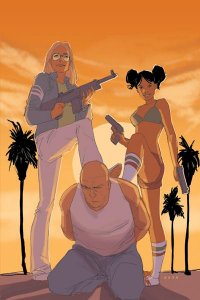
By Jeb D.
First of all, 32 pages of story for a buck… can’t really go too far wrong. And, indeed, there’s at least a dollar’s worth of fun in this comic, but it’s not where you might expect to find it.
The story opens with our “Freelancers” in action. And it’s your typical in situ intro; everyone in the story seems to know the score already: that “Freelancers” with a capital “F”, are members of some sort of corporate espionage-investigative-black-ops-mischief organization, and the fact that our protagonists (one white, one black) are bantering back and forth while preparing to grab their target, and relieve him of a priceless cat of rare breed, by means of a retrieval plan that relies on car chases and dangerous physical “stunts,” means that they’re your typical action-movie buddies. Naturally, they have a rival in the organization who’s trying to cut them out of the plum assignments, and when they’re told by their boss to back off and let the rival take over… well, you can imagine how well that goes down: undeterred, they press on (with lots more banter), and following their discovery that the assignment involves a mystery with roots in their shared history, the issue ends in an explosive cliffhanger.
Now, if you’ve taken a peek at the cover graphic over there, you’ve probably noticed that I omitted to mention the gender of the buddies in question: Cassie (blond and stacked) and Val (ponytailed and feisty) are Danger Girl-style female operatives, with all that implies: yes, it’s nice to see more female leads in comics; no, it’s not particularly interesting when the storyline and dialogue just feel recycled from endless male-oriented buddy-action comics and movies. Now, part of the reason for this might be that this story wasn’t actually done by the creators of these “Freelancers,” Matt Gagnon and Felipe Smith, but handed off, for some reason, to writer Ian Brill and artist Joshua Covey. Brill’s snappy patter is appropriately brisk, but gets a little wearing after a while, and Covey’s bright (thanks to three different colorists), cartoony work is appealing enough, if not particularly polished in the storytelling department (it’s also a little odd that the usual barrage of “variant” cover artists, including Phil Noto, Khary Randolph, and Stephane Roux, were evidently working from different character model sheets than Covey, since several of them depict Cassie with more natural proportions, and wearing glasses). It’s not impossible this story might develop into something compelling, but there’s not a lot of evidence of that to this point.
But here’s the weird bit: the six-page backup story, “Tiny Fighters,” which delves into Val and Cassie’s past, is by Gagnon and Smith, and is rather delightful.
The women, you see, grew up as products of the “House of Little Fortunes”: a sort of combination orphanage and dojo in L.A., and we meet them here as pre-teens, doing the kind of household chores that orphans usually get tasked with (scrubbing floors, doing dishes, etc.). Val’s feistiness doesn’t sit well with the “Big Sister” in charge of them (though, to be fair, having one of your pre-adolescent charges slack off the laundry by snapping “Bitch, I need a break!”, while flashing gang signs, might try anyone’s patience). When Val is kicked out onto the mean streets, the loyal Cassie follows, to have her back. Smith’s art is wonderfully imaginative, and the raucous Skid Row bums that menace the girls (and who seriously regret doing so) are visualized as almost Sendak-like figures of mythic proportions. The “attitude” that feels rote in the story of the adult Val and Cassie is more organic here, as we’re watching the pair start to develop a friendship based on their need for, and support of, each other, rather than their adoption of the more conventional “ass-kicking-babe” attitudes we get in Brill and Covey’s chapter (there’s also nothing in the “grown-up” story as funny, fresh, and perceptive as the girls’ regret over having to deal with the bums by “pounding their balls into the dust,” seeing as how they’re just as abandoned as the two orphans). In the end, they’re welcomed back to the dojo (in a somewhat cheesy plot twist), and you marvel at just how much actual story they worked into such a short space. I, for one, hope that we’re not done with the adventures of these two Tiny Fighters.
I have no idea what’s in store for this comic; while I’d enjoy more “Tiny Fighters,” I’m also curious to see if Gagnon and Smith have any plans to bring their engaging vision to the grown-up versions of their creations in future issues: that, I’d buy. As it is, I’ll give this one a recommendation, mostly based on the fact that, as I say, you do get one good story for your buck, even if it is a pretty short one.
Rating: 




Out of a Possible 5 Stars
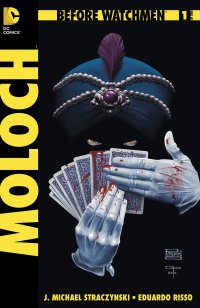 Before Watchmen: Moloch #1 (DC, $3.99)
Before Watchmen: Moloch #1 (DC, $3.99)
By Adam Prosser
The tragedy of Before Watchmen is how inessential it’s been. There have terrible or mediocre comic “events” before now, obviously, but they usually fulfill their purpose of getting attention and having people talk about them. And yet, while “Before”’s sales have been decent—–decent, not spectacular—–it’s already feeling like something that’s slipping from the public memory, and it’s barely even half finished yet. I certainly haven’t seen much discussion of it beyond the initial wave of nausea. I know that when Moloch #1 was announced, I felt a definite sense of “Oh yeah, that’s still happening, isn’t it?” Considering that I had felt very passionately about Before Watchmen (in a negative sense) when it first launched, I can’t imagine this is a particularly good sign for the series.
But who knows. Maybe there are hundreds of gleaming-eyed Before Watchmen fans out there who ran breathlessly to their comic shops to grab this comic. Maybe this is being discussed obsessively on internet message boards to which I’m not privy. Maybe I’m the one who’s out of touch. In any case, you probably already know how you feel about Before Watchmen, so how is this issue?
This is actually two comics, in a sense. The first tells the very EC Comics-style tale of young Edgar Jacobs, his cruel childhood (he’s turned into a literal freak here, despite simply being a somewhat ugly guy with slightly pointy ears in the original graphic novel) and how he used stage magic to get his vengeance on those who had wronged him. This part is honestly not bad.
The second half sinks more into cliché and predictability as we see Moloch’s transformation into a supervillain, though the brief appearances of the two Watchmen characters, Doc Manhattan and Ozymandias, both make for rather well-done moments. Unfortunately, neither these, nor Eduardo Risso’s typically slick and stylized artwork, are really enough to overcome the fundamental pointlessness this story projects. As usual, there’s nothing in J. Michael Straczynski’s script here that you couldn’t really have absorbed from the original Watchmen graphic novel.
This is a shame, as a Moloch story is one of the more potentially interesting Watchmen spinoffs, and as with the Minutemen or the Tales of the Black Freighter, it might have actually broken new ground. But like the Minutemen, the story circles around to cling to the events of Watchmen, making this nothing but padding. The ending, admittedly, hints at a potentially interesting twist–—and an unconvincing redemption for the lead character—–but the series was already “potentially interesting” before I cracked it open, and that potential never paid off.
Rating: 




Out of a Possible 5 Stars
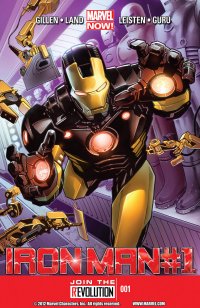 Iron Man #1 (Marvel, $3.99)
Iron Man #1 (Marvel, $3.99)
By Jeb D.
I’m sorry… I keep trying to make excuses for Greg Land, but I’m losing interest. I’ve given him credit for developing and improving his sequential work over the years, but for some reason, that development hasn’t tempted him away from the ludicrous full-face photo-traced porn-model posing that he assigns to his female characters. Look, the first time we meet Tony Stark in this book, he’s chatting up a hot woman in a fancy bar (to the bemused disgust of Pepper Potts); and even in that setting, the depiction of the female characters is almost embarrassingly sexed-up and phony (for all its photo “realism”). And while I’m hardly immune to the charms of an enticingly-portrayed woman, this sort of thing makes Frank Cho or Terry Dodson look like prudes.
Writer Kieron Gillen is running the Marvel movie-verse playbook here, which is fine, really: Matt Fraction was the first writer to consistently find interesting things to do with Stark since the old “Demon in a Bottle” days, and the callbacks here to Warren Ellis’ “Extremis” storyline, and its integration into the upcoming Iron Man 3, should provide him an opportunity to continue Fraction’s good work while remaining more or less in synch with what Shane Black and Downey have on offer next spring. It’s a good opening chapter, with brisk scene-setting, and just enough exposition to allow time for Tony to do a little detective work before starting the armored beat-downs; the ending is a little abrupt, considering that the story is being driven by the brutal death of a briefly-reappearing supporting character, but it’s more thoughtful than your typical “To Be Continued” cliffhanger. Given its need to strike a balance among the new series’ various debts to Fraction, Black, Ellis, and Downey, the script is a model of good construction.
And to return to the subject of being fair to Greg Land: I suppose that photo-referencing isn’t the worst way to make Tony’s armor look like a realistic piece of machinery, rather than a colorful track suit; and at least, when Land draws Iron Man himself, he doesn’t have to worry about convincing facial expressions. So, on balance, I guess this is probably the right book for him.
Rating: 




Out of a Possible 5 Stars